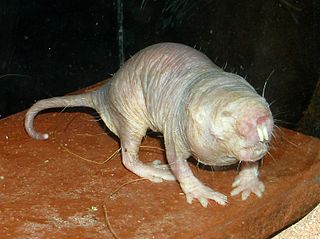Related Research Articles

Brown adipose tissue (BAT) or brown fat makes up the adipose organ together with white adipose tissue. Brown adipose tissue is found in almost all mammals.
Mole-rat or mole rat can refer to several groups of burrowing Old World rodents:

The naked mole-rat, also known as the sand puppy, is a burrowing rodent native to the Horn of Africa and parts of Kenya, notably in Somali regions. It is closely related to the blesmols and is the only species in the genus Heterocephalus.

In biology, a dominance hierarchy is a type of social hierarchy that arises when members of animal social groups interact, creating a ranking system. A dominant higher-ranking individual is sometimes called an alpha, and the submissive lower-ranking individual a beta. Different types of interactions can result in dominance depending on the species, including ritualized displays of aggression or direct physical violence. In social living groups, members are likely to compete for access to limited resources and mating opportunities. Rather than fighting each time they meet, relative rank is established between individuals of the same sex, with higher-ranking individuals often gaining more access to resources and mates. Based on repetitive interactions, a social order is created that is subject to change each time a dominant animal is challenged by a subordinate one.
Biological immortality is a state in which the rate of mortality from senescence is stable or decreasing, thus decoupling it from chronological age. Various unicellular and multicellular species, including some vertebrates, achieve this state either throughout their existence or after living long enough. A biologically immortal living being can still die from means other than senescence, such as through injury, poison, disease, lack of available resources, or changes to environment.
Glabrousness is the technical term for a lack of hair, down, setae, trichomes or other such covering. A glabrous surface may be a natural characteristic of all or part of a plant or animal, or be due to loss because of a physical condition, such as alopecia universalis in humans, which causes hair to fall out or not regrow.
Richard D. Alexander was an American zoologist who was a professor at the University of Michigan and curator at the university's museum of zoology of in Ann Arbor, Michigan. His scientific pursuits integrated the fields of systematics, ecology, evolution, natural history and behavior. The salient organisms in his research are wide-ranging, from the orthopterans and cicadidae (cicadas) to vertebrates: dogs, horses, and primates, including humans.

A poikilotherm is an animal whose internal temperature varies considerably. Poikilotherms have to survive and adapt to environmental stress. One of the most important stressors is temperature change, which can lead to alterations in membrane lipid order and can cause protein unfolding and denaturation at elevated temperatures. It is the opposite of a homeotherm, an animal which maintains thermal homeostasis. While the term in principle can apply to all organisms, it is generally only applied to animals, and mostly to vertebrates. Usually the fluctuations are consequence of variation in the ambient environmental temperature. Many terrestrial ectotherms are poikilothermic. However some ectotherms remain in temperature-constant environments to the point that they are actually able to maintain a constant internal temperature .It is this distinction that often makes the term "poikilotherm" more useful than the vernacular "cold-blooded", which is sometimes used to refer to ectotherms more generally.

The blesmols, also known as mole-rats, or African mole-rats, are burrowing rodents of the family Bathyergidae. They represent a distinct evolution of a subterranean life among rodents much like the pocket gophers of North America, the tuco-tucos in South America, or the Spalacidae from Eurasia.

Sociality is the degree to which individuals in an animal population tend to associate in social groups (gregariousness) and form cooperative societies.

The northeast African mole-rat is a species of rodent in the family Spalacidae and is found in Ethiopia, Somalia, and northwest Kenya. Its natural habitats are subtropical or tropical moist montane forests, dry savanna, high-altitude shrubland and grassland. It lives a solitary existence underground and produces a small litter of pups twice a year, in the two rainy seasons. Some taxonomic authorities lump this species, along with a number of others in the genus, in which case the English name East African mole-rat is used.

Clariallabes is a genus of airbreathing catfishes found in Africa.
The Shungura Formation is a stratigraphic formation located in the Omo river basin in Ethiopia. It dates to the Late Pliocene to Early Pleistocene. Oldowan tools have been found in the formation, suggesting early use of stone tools by hominins. Among many others, fossils of Panthera were found in Member G of the formation.
Bite force quotient (BFQ) is a numerical value commonly used to represent the bite force of an animal, while also taking factors like the animal's size into account.
H. glaber may refer to:
Dolichodorus is a genus of nematodes known commonly as awl nematodes. They are distributed worldwide. They are ectoparasites of plant roots, and some are pests of agricultural crops.

Piestus is a genus of flat rove beetles in the family Staphylinidae. There are more than 30 described species in Piestus.